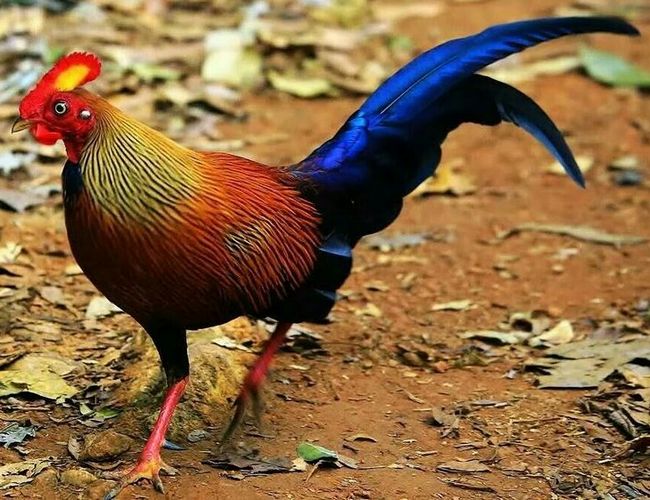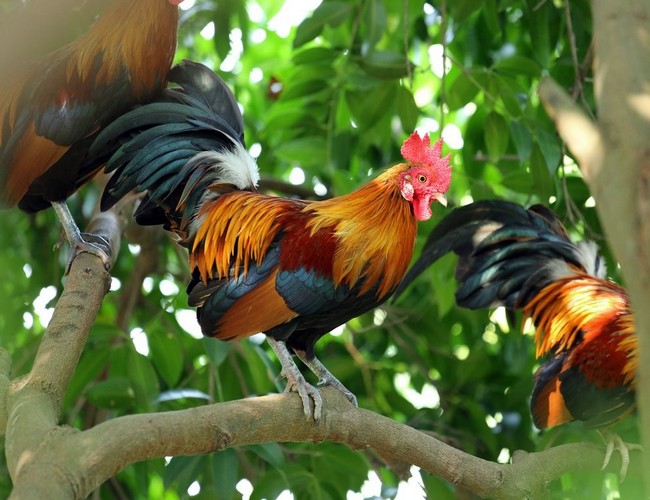
Jungle Fowl
The national bird of Sri Lanka is Jungle Fowl (Gallus lafayettii) also known as the Ceylon jungle fowl. Its scientific name is Gallus. It belongs to the family of Phasianidae class of Aves and kingdom of Animalia. By order it is a member of the Galliformes bird which is common to Sri Lanka. It is similar to the red jungle fowl (G. gallus).
It is actually the wild jungle fowl from which the chicken was domesticated. The specific name of this bird memorializes the French aristocrat Gilbert du Motier, marquis de La Fayette. In the Sinhala language which is the popular and native language of an ethnic group of sri lanka.
It is known as (Wali Kukula). And in the Tamil language. It is known as (Ilaṅkaik kāṭṭukkōḻi). Length wise the male species of jungle fowl ranges from 65–73 cm (25–29 inch).
Its weight ranges from 790–1,140 g (1.74–2.51 lb). It closely resembles with a powerful hen. The body feathers color of male species is orange-red.its wings and tail dark purple to black. The man fur color changes in descending order from head to the base of the spinal column are golden. And the face has plain red skin and wattles.
The fleshy red crest on the head of a fowl (comb) is red with a yellow Center. There are three types of jungle fowl like, green jungle fowl, grey jungle fowl, and red jungle fowl. Sri lankan jungle fowl does not hold hidden plumage as compared to green jungle fowl
The female JungleFowl is much smaller than man. Length-wise it is 35 cm (14 in) long. Its weight ranging from 510 to 645 g (1.124–1.422 lb). Its features dark brown with white pattern designing on the lower belly and breast.it provides ultimate mask or cover for a nesting bird.
Sri Lankan jungle fowl have same sexual behavior just like other jungle fowl. It is sexually dimorphic that is it exist in two different forms. The male kind of Sri Lankan jungle fowl closely related to the red jungle. Its Female kind is closely related to grey jungle fowl.
10 Facts about jungle fowl
- Junglefowl is the most popular and native bird of Sri Lanka country.
- It is the wild ancestors of all domestic poultry.
- Originally it has five subspecies. Which differentiate by the color of facial lappets, size of the combs, and in the length.
- During the non-breeding season i.e. summer, autumn and winter it lives in small mixed groups.
- Its social system is hierarchical in nature .That’s why it is in ‘pecking order’ for both males and females.
- At the start of the breeding season which arise in the spring. The species of stronger cocks maintains a territory with three to five 3-5 hens.
- It has been reported on the experimental basis that females have the ability to retain or emit, eject sperm.
- The Experiment also shows that the female kind constantly retains the sperm of the one or two dominant roosters (fowls) in the group and eject that of all others.
- The production rate hen eggs typically range from four to seven (4-7) or it may be four to six (4-6) eggs per clutch or hold.
- Its incubation period complete in 18 to 20 days by the female species only.
- Sri Lankan junglefowl mostly found in India, Sri Lanka and south East Asia.
- The staple food for this bird is seed .It means they are seed-eaters but sometimes insects are also taken especially by the young birds.
- It could be kept for eggs and meat. Having many benefits it requires little care. And in need it can be sold to tide a family over until crops are ready.
- In Egypt and China Chickens were elevated for meat and eggs by 1400 B.C. Greeks ate them.
- At the time of Romans arrivals they were also found in Britain. It was introduced by explorers and conquistadors (an adventurer (especially one who led the Spanish conquest of Mexico and Peru in the 16th century) in the new world.
- Due its importance as it is key role in meat and egg foods .Its production has increased over the years by new scientific method.
- The surveyor reports show that in 1920 hens laid about 120 eggs a year and it took 16 weeks to raise a two pound meat bird. Today hens lay 300 eggs or more a year and four pound meat bird can be raised in four weeks.
History of Jungle Fowl
Its scientific history shows that the genus Gallus was found all over Eurasia mostly. Actually, it is evolved in southeastern Europe. The French zoologist and natural philosopher Mathurin Jacques Brisson (30 April 1723 – 23 June 1806) formally published a research paper about jungle fowl. More information about history is found on this link(Giant jungle fowl Gallus karabachensis (Early Pleistocene of Nagorno-Karabakh).
Why is Jungle Fowl the National bird of Sri Lanka ?
The jungle fowl are large birds and exist in different colors. They are seed-eaters. But insects are also taken, especially by the young birds.
Its historical importance is popular and accepted widely because it is considered as ancestor of the domesticated chickens.
They are conventionally have been valued by villagers. Because they are used as source of meat and protein. And some of its species can be hunt for food on their own behalf without cost. The male species called a cock or rooster.
A female is called a hen. Young are called chicks. A group is called a flock. Large source of domestic, wild, playing and zoo. Having enormous property and benefits the people of Sri Lanka and his government accepted it as national bird. Due to all these facts the jungle fowl becomes the official and national bird of Sri Lanka country. This was a detailed guide about JungleFowl Bird. Kindly do let us share your thoughts about it.
Read also: National Bird of Armenia

